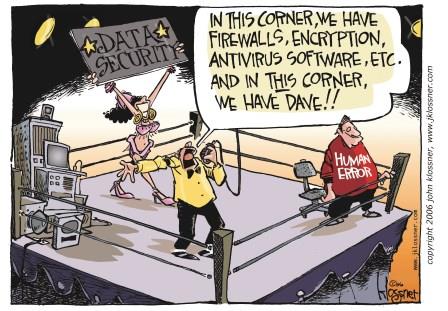One of the most common sources of data breaches in online security is human error, specifically, employees at organizations leave security systems vulnerable by making common mistakes that are easily remedied.
Weak Password Security
It’s easy to remember a password made up of your birthday or child’s name, but it’s also easy to guess such a password, or crack it by brute-force attack. This is a typical mistake that allows malicious perpetrators full access to a system containing sensitive, private information.
Sharing passwords is always a risk, as you never know who else the password will be passed along to, including other employees with less-than-good intentions.
Finally, too many employees use the same password across multiple platforms, which means that if one account is breached, so can the rest.
Careless Handling of Data
The amount of data that goes across most virtual desk in a day is often huge. It is certainly not unheard of for an employee to type an email recipient’s address wrong or attach the wrong document to the email and thus accidentally send sensitive information to the wrong person.
Other mistakes can include deleting important information, not realizing the importance of the document in question.
Low Security Awareness
Not everyone is up-to-date on secure online practices. Many employees neglect to update their software because the pop-up reminder comes at an inopportune time and they don’t realize the importance of keeping their system up-to-date.
Far too often, even the most intelligent people fall prey to phishing scams and click on malicious email links, thinking them harmless. Downloading unauthorized software can also create vulnerabilities in the system, as can plugging in insecure devices, such as USB storage sticks that originate from outside the organization.
How to Handle Cybersecurity Breaches Resulting from Human Error
Cybersecurity awareness training is essential for all employees and should take place on a regular basis. Most employees simply don’t know enough about the risks involved and what the costs are. Since most of the employee security breaches are unintentional and simply alerting them to the problem is enough to drastically reduce the number of breaches.
One important and effective way to train employees in cybersecurity awareness is to simulate phishing scams and train employees to identify malicious links in emails.
In addition, limiting employee’s access to information can help limit the amount of damage any single security breach can do to the system. A system where employees are privy only to information pertinent to their job is better, from a security standpoint, than a system where employees have access to all the organization’s information as a default. If an employee’s password is stolen, for example, there is less information available to the thief and hacking through to the rest of the system will set off alarms.
Finally, while education and limiting access to information are both important steps to securing information, some form of monitoring can help, both as a deterrent and in pinpointing when and how breaches occurred. Systems that can archive the flow of data between employees and between employees and clients will allow experts to track security and deal with breaches more effectively.


